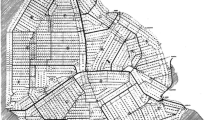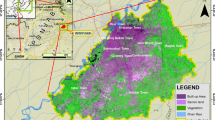Abstract
Urban agglomerations, which are highly integrated urban groups, form during the advanced stages of industrialization and urban development. The urban agglomeration on the northern slope of the Tianshan Mountains is one of the 19 urban agglomerations promoted by China’s 13th Five-Year Plan and a key area of urbanization in **njiang. Based on remote sensing data, we analyzed the expansion of construction land in the urban agglomeration on the northern slope of the Tianshan Mountains and its effect on ecological value in 1980–2015. The results show that the expansion of construction land significantly affected ecological value in the study area over the past 35 years. Among land use types, grassland was the dominant contributor to changes in ecological value; its contribution rate reached 66.27% with an interannual variation of only 5%. The contribution rate of urban and rural residential land along with industrial and mining lands was very low (0.82%), while the interannual variation was large (86%). The area of construction land in the urban agglomeration expanded from 1,067 to 2,586 km2, and the conversions of different land use types had different effects on ecological value. Among land use types, the conversions of low-coverage grassland and dry land made the largest contributions to changes in ecological value. During the study period, a total of 1,685 km2 of ecological land, 69.91% of which belonged to cultivated land and grassland, was converted into construction land. A total area of 1,082 km2 of dry land and low-coverage grassland was converted into construction land, accounting for 64.21% of the total ecological land that was converted into construction land. In 2000–2015, the area of urban construction land increased significantly along with the proportion of unused land, including gobi (172 km2), bare land (65 km2), and salt-affected land (65 km2), being converted into construction land. In contrast, the area of construction land that was converted into ecological land was less than 166 km2. The areas with the largest expansions of construction land were concentrated in Urumqi, Karamay, and Changji, where the areas of construction land increased by 399, 186, and 126 km2, respectively. The areas with the most rapid expansions in construction land were concentrated in Kuytun, Toksun, and Usu. The environmental effects of construction land expansion and land use change were more positive in the late stage of urban agglomeration (2000–2015) compared to in the early stage (1980–2000). Kuytun City, Shihezi City, and Wujiaqu City showed large changes in ecological value caused by the expansion of construction land, whereas the changes in ecological value in the 14 other cities were relatively small, and the expansion of construction land slowed in 2000–2015 compared to in 1980–2000. In the future, further development of the urban agglomeration on the northern slope of the Tianshan Mountains should fully consider the sensitivity and carrying capacity of the vulnerable ecological environment in this area. Population growth and industrial development in the urban agglomeration should be controlled based on the available water resources and ecological capacity to reduce the pressure on the environment and ensure sustainable development.
Similar content being viewed by others
References
Alnawaiseh N A, Hashim J H, Md Isa Z. 2015. Relationship between vehicle count and particulate air pollution in Amman, Jordan. Asia Pac J Public Health, 27: NP1742–NP1751
Anderson P M L, O’Farrell P J. 2012. An ecological view of the history of the city of Cape Town. Ecol Soc, 17: 12
Bao C, Fang C L. 2007. Water resources constraint force on urbanization in water deficient regions: A case study of the Hexi Corridor, arid area of NW China. Ecol Econ, 62: 508–517
Barbera E, Currò C, Valenti G. 2010. A hyperbolic model for the effects of urbanization on air pollution. Appl Math Model, 34: 2192–2202
Brown A. 2012. Scenario analysis: Urbanization emissions. Nat Clim Change, 2: 394
Chen X, Luo G P, **a J, Zhou K F, Lou S P, Ye M Q. 2004. Ecological response to the climate change on the northern slope of the Tianshan Mountains in **njiang. Sci China Ser D-Earth Sci, 48: 765–777
Cheng W M, Zhou C H, Liu H J, Zhang Y, Jiang Y, Zhang Y C, Yao Y H. 2006. The oasis expansion and eco-environment change over the last 50 years in Manas River Valley, **njiang. Sci China Ser D-Earth Sci, 49: 163–175
Costantini V, Monni S. 2008. Environment, human development and economic growth. Ecol Econ, 64: 867–880
Deng J S, Wang K, Hong Y, Qi J G. 2009. Spatio-temporal dynamics and evolution of land use change and landscape pattern in response to rapid urbanization. Landscape Urban Plan, 92: 187–198
Fang C L, Song J T, Lin X Q. 2010. Theory and Practice of Sustainable Development of China’s Urban Agglomerations. Bei**g: Science Press. 56–89
Fang C L, Yao S M, Liu S H. 2011. 2010 China Urban Agglomeration Development Report. Bei**g: Science Press. 25–33
Fang C L. 2015. Important progress and future direction of studies on China’s urban agglomerations. J Geogr Sci, 25: 1003–1024
Fang C L, Liu H M, Li G D. 2016. International progress and evaluation on interactive coupling effects between urbanization and the eco-environment. J Geogr Sci, 26: 1081–1116
Fang C L, Yu D L. 2017. Urban agglomeration: An evolving concept of an emerging phenomenon. Landscape Urban Plan, 162: 126–136
Fang C L, Ren Y F. 2017. Analysis of emergy-based metabolic efficiency and environmental pressure on the local coupling and telecoupling between urbanization and the eco-environment in the Bei**g-Tian**-Hebei urban agglomeration. Sci China Earth Sci, 60: 1083–1097
Grimm N B, Faeth S H, Golubiewski N E, Redman C L, Wu J G, Bai X M, Briggs J M. 2008. Global change and the ecology of cities. Science, 319: 756–760
Habitat U. 1996. An Urbanizing World, Global Report on Human Settlements. Nairobi: UN Human Settlements Programme
Hull V, Tuanmu M N, Liu J. 2015. Synthesis of human-nature feedbacks. Ecol Soc, 20: 17
Jiang G H, Zhang F R, Kong X B, Zhao H F, Chen J W, Su Z Y. 2006. The spatial differentiation of construction land expansion in Bei**g mountainous area (in Chinese). Geogr Res, 25: 905–912
Kalnay E, Cai M. 2003. Impact of urbanization and land-use change on climate. Nature, 423: 528–531
Kennedy C, Pincetl S, Bunje P. 2011. The study of urban metabolism and its applications to urban planning and design. Environ Pollut, 159: 1965–1973
Kline J D, Moses A, Alig R J. 2001. Integrating urbanization into landscape-level ecological assessments. Ecosystems, 4: 3–18
Kuang W H, Yang T R, Liu A L, Zhang C, Lu D S, Chi W F. 2017. An EcoCity model for regulating urban land cover structure and thermal environment: Taking Bei**g as an example. Sci China Earth Sci, 60: 1098–1109
Li S, Zhang X L, Li S S, Du H R. 2013. Spatial and temporal evolution and mechanism of landscape pattern of oasis of urban in **njiang (in Chinese). Econ Geogr, 33: 161–168
Li X W, Fang C L, Huang J C, Mao H Y. 2003. The urban land use transformation and associated effects on eco-environment in Northwest China arid region (in Chinese). Quat Sci, 23: 281–290
Liu S H, He S J. 2002. A spatial analysis model for measuring the rate of land use change (in Chinese). J Nat Resour, 17: 533–540
Luo H B, Huang G, Wu X M, Peng J, Fu X Y, Luo L. 2009. Ecological engineering analysis and eco-hydrodynamic simulation of tidal rivers in Shenzhen City of China. Ecol Eng, 35: 1129–1137
McMichael A J, Woodruff R E, Hales S. 2006. Climate change and human health: Present and future risks. Lancet, 367: 859–869
Meerow S, Newell J P. 2015. Resilience and complexity: A bibliometric review and prospects for industrial ecology. J Ind Ecol, 19: 236–251
Ren W W, Zhong Y, Meligrana J, Anderson B, Watt W E, Chen J K, Leung H L. 2003. Urbanization, land use, and water quality in Shanghai. Environ Int, 29: 649–659
Salim R A, Shafiei S. 2014. Urbanization and renewable and non-renewable energy consumption in OECD countries: An empirical analysis. Econ Model, 38: 581–591
Scholz R W, Binder C R. 2011. Environmental Literacy in Science and Society: From Knowledge to Decisions. Cambridge University Press. 453–462
Trusilova K, Churkina G. 2008. The response of the terrestrial biosphere to urbanization: Land cover conversion, climate, and urban pollution. Biogeosciences, 5: 1505–1515
Wang H W, Zhang X L, Wei S F, Kang H. 2006. Analysis on the coupling law between economic development and the environment in Ürümqi city. Sci China Ser D-Earth Sci, 50: 149–158
Wang S Y, Liu J Y, Zhang Z X, Zhou Q B, Zhao X L. 2001. Analysis of temporal and spatial characteristics of land use in China (in Chinese). Acta Geogr Sin, 56: 631–639
Wang X R, He X D, Miao S G, Dou Y J. 2018. Numerical simulation of the influence of aerosol radiation effect on urban boundary layer. Sci China Earth Sci, 61: 1844–1858
Xu L, Liu S B, Liu Y G, Wu J Y, Nuzaaiti A, Song H X, Chen B B. 2009. Effect of land use change on ecosystem services value in red soil hilly region of central Hunan Province—A case study in Changsha City (in Chinese). Acta Sci Circum, 29: 1788–1792
Yao S M, Zhou C S, Wang D, **u C L, Wang C X, Chen M X. 2016. New Perspectives on Urban Agglomerations in China. Bei**g: Science Press. 14–15
Yang L, Ouyang H, Fang K N, Ye L L, Zhang J. 2015. Evaluation of regional environmental efficiencies in China based on super-efficiency-DEA. Ecol Indic, 51: 13–19
Zanella A, Camanho A S, Dias T G. 2015. The assessment of cities’ livability integrating human wellbeing and environmental impact. Ann Oper Res, 226: 695–726
Zawar R P, Appelhans T, Gharaylou M, Shamsipour A. 2010. Mesoscale controls on particulate matter pollution for a mega city in a semi-arid mountainous environment: Tehran, Iran. Int J Environ Pollut, 41: 166–183
Zhao W Y, Li J L, Chen Y N. 2008. Changes of eco-capacity and ecological sustainability in the north Tianshan Mountains region: Taking Fukang county as a case of study (in Chinese). Acta Ecol Sin, 28: 4363–4371
Zhang J J, Yang D G, Zhang Y F, Chen Z J. 2007. Studies of the urban-rural spatial evolvement in the northern slope of Tian mountain based on the GIS and fractal theory (in Chinese). Resour Sci, 29: 83–89
Zhang Y F, Yang D G, Zhang X L, Ma W H, Zhang H Y. 2006. Spatial-temporal changes of urban spatial morphology at the northern slope of the Tianshan Mountains (in Chinese). Prog Geo, 25: 138–147
Zhu H Y, Li X B. 2003. Discussion on the index method of regional land use change (in Chinese). Acta Geogr Sin, 58: 643–650
Acknowledgements
We sincerely appreciate the constructive comments and suggestions of the anonymous reviewers. This work was supported by the Major Program of the National Natural Science Foundation of China (Grant No. 41590842) and the Strategic Priority Research Program (A) of the Chinese Academy of Sciences (Grant No. XDA20040400).
Author information
Authors and Affiliations
Corresponding author
Rights and permissions
About this article
Cite this article
Fang, C., Gao, Q., Zhang, X. et al. Spatiotemporal characteristics of the expansion of an urban agglomeration and its effect on the eco-environment: Case study on the northern slope of the Tianshan Mountains. Sci. China Earth Sci. 62, 1461–1472 (2019). https://doi.org/10.1007/s11430-018-9369-x
Received:
Revised:
Accepted:
Published:
Issue Date:
DOI: https://doi.org/10.1007/s11430-018-9369-x




